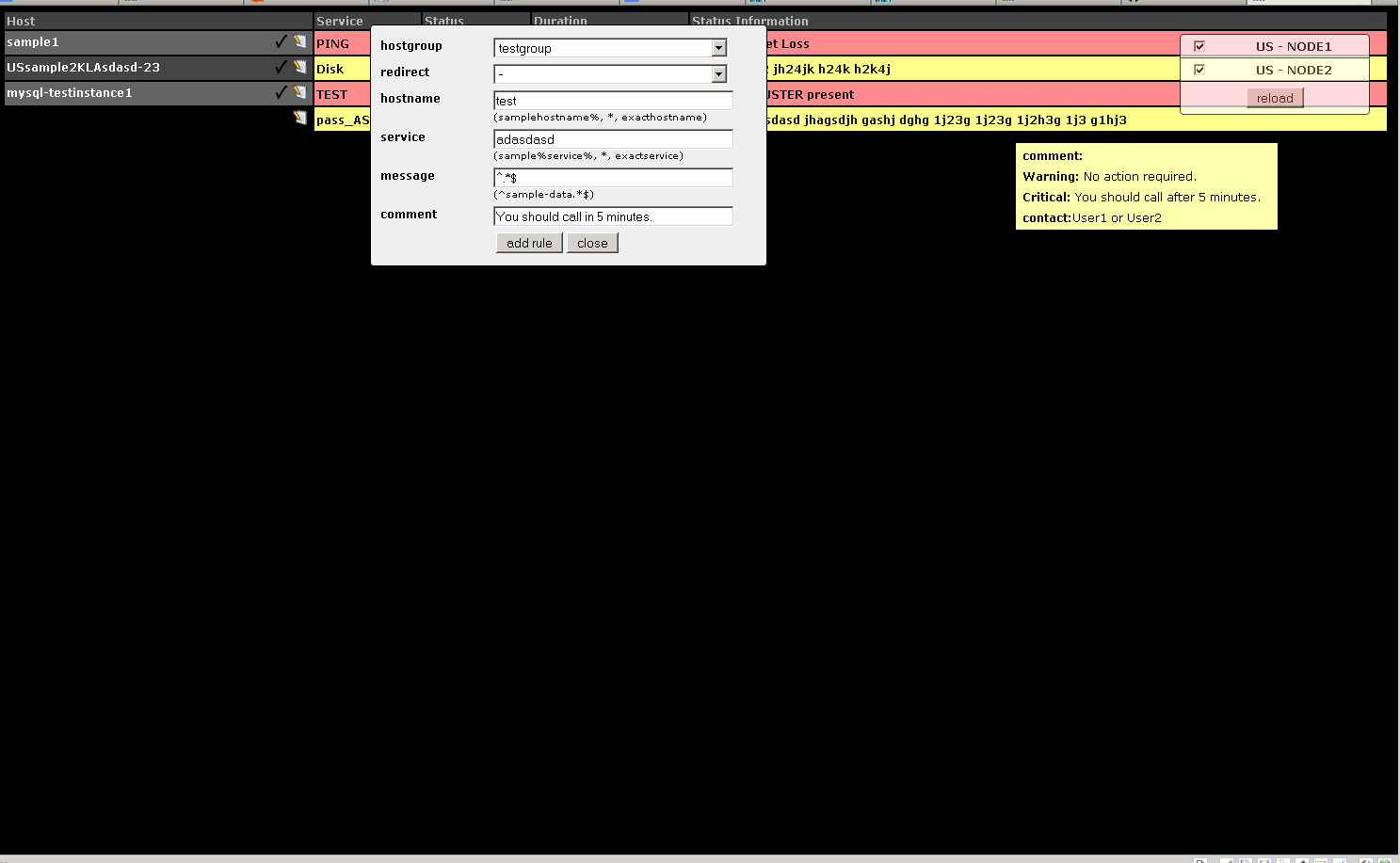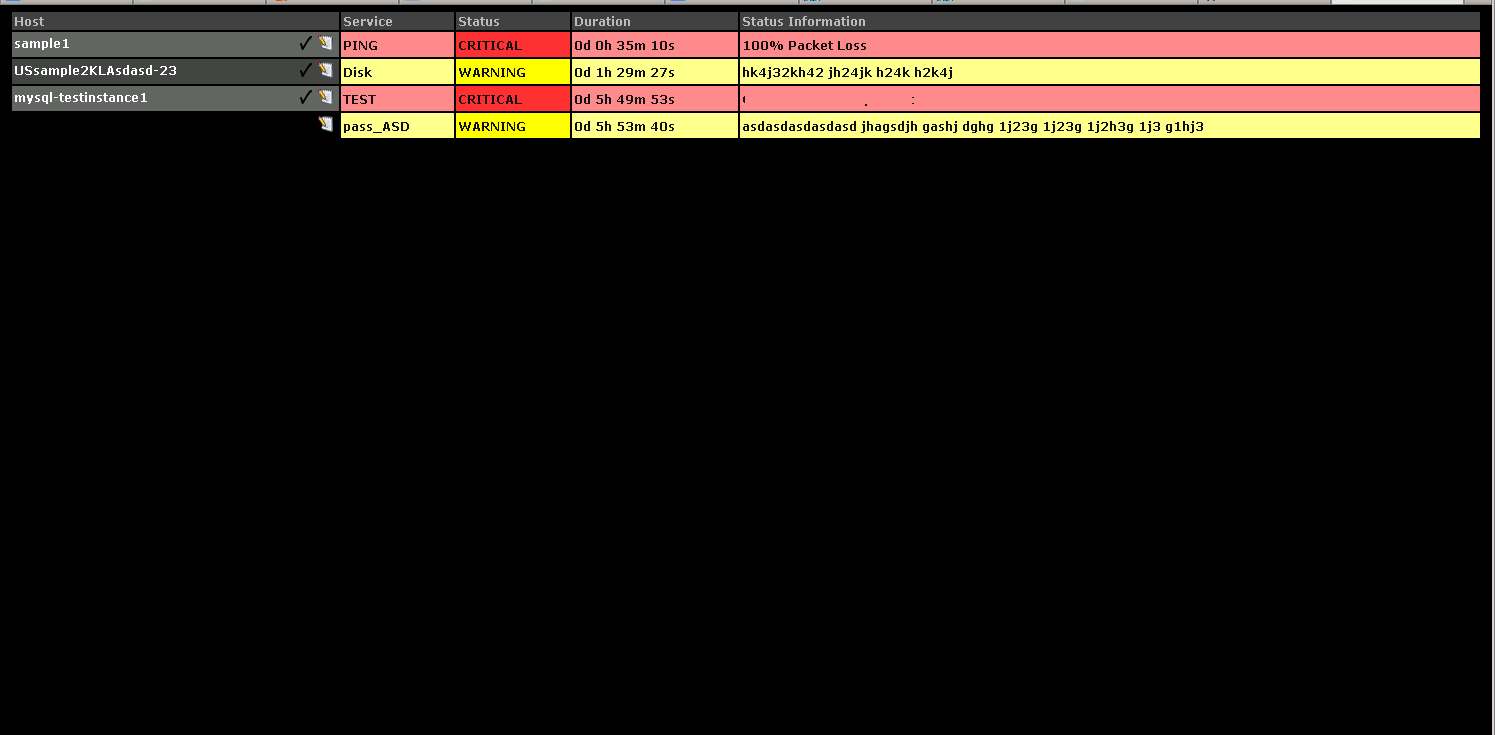Nagios Status to JSON/JSONP/Console.
- Everything should be automatic. It tries to find the nagios configuration and locate the status.dat and parse it. If something is wrong or you are using exotic nagios configuration, you can set the statusdat as a parameter.
- It works on Linux and BSD also.
- The parser is much faster than the built-in nagios parser. (Using the nagios cgi scripts the parsing takes 3+ seconds. With this It takes ~0.1s)
I am using this as a backend for my nagios aggregator front-end. So with this you can aggregate multiple nagios instances.
- make/gmake for makefile
- c++ compiler
- gmake / make
- copy the binary to the nagios cgi directory
user@monitor1:~$ /mnt/data/nagios/sbin/nagios2json.cgi
example1 | PING | CRITICAL | 12d 3h 11m 8s | "PING CRITICAL - Packet loss = 100%"
example2 | PORT-80 | CRITICAL | 18d 7h 44m 45s | "Connection refused"
user@monitor1:~$ curl http://monitor1/nagios/cgi-bin/nagios2json.cgi?servicestatustypes=28&serviceprops=...
{
"version":20110619,
"running":1,
"servertime":1409075862,
"localtime":[1,7200],
"created":1409075855,
"data":
[
{
"last_state_change": 1409075855,
"plugin_output":"PING CRITICAL - Packet loss = 100%",
"status":"WARNING",
"flags":1485146,
"hostname":"examplehost",
"service":"PING",
"host_alive":1,
"services_total":10,
"services_visible":1,
"duration":"0d 0h 0m 0s"
}
]
}
You can add &callback=FNNAME for JSONP
-s, --status=[FILE] nagios status.dat path -c, --cgi cgi mode -j, --json json output -t, --servicestatustypes service status type (OK/CRIT/WARN) -p, --serviceprops service props (ACK/MAINTENANCE) -n, --hostprops host props (ACK/MAINTENANCE)
hostprops: HOST_SCHEDULED_DOWNTIME 1 HOST_NO_SCHEDULED_DOWNTIME 2 HOST_STATE_ACKNOWLEDGED 4 HOST_STATE_UNACKNOWLEDGED 8 HOST_CHECKS_DISABLED 16 HOST_CHECKS_ENABLED 32 HOST_EVENT_HANDLER_DISABLED 64 HOST_EVENT_HANDLER_ENABLED 128 HOST_FLAP_DETECTION_DISABLED 256 HOST_FLAP_DETECTION_ENABLED 512 HOST_IS_FLAPPING 1024 HOST_IS_NOT_FLAPPING 2048 HOST_NOTIFICATIONS_DISABLED 4096 HOST_NOTIFICATIONS_ENABLED 8192 HOST_PASSIVE_CHECKS_DISABLED 16384 HOST_PASSIVE_CHECKS_ENABLED 32768 HOST_PASSIVE_CHECK 65536 HOST_ACTIVE_CHECK 131072 HOST_HARD_STATE 262144 HOST_SOFT_STATE 524288 HOST_ACTIVE_CHECKS_DISABLED 1048576 HOST_ACTIVE_CHECKS_ENABLED 2097152 serviceprops: SERVICE_SCHEDULED_DOWNTIME 1 SERVICE_NO_SCHEDULED_DOWNTIME 2 SERVICE_STATE_ACKNOWLEDGED 4 SERVICE_STATE_UNACKNOWLEDGED 8 SERVICE_CHECKS_DISABLED 16 SERVICE_CHECKS_ENABLED 32 SERVICE_EVENT_HANDLER_DISABLED 64 SERVICE_EVENT_HANDLER_ENABLED 128 SERVICE_FLAP_DETECTION_ENABLED 256 SERVICE_FLAP_DETECTION_DISABLED 512 SERVICE_IS_FLAPPING 1024 SERVICE_IS_NOT_FLAPPING 2048 SERVICE_NOTIFICATIONS_DISABLED 4096 SERVICE_NOTIFICATIONS_ENABLED 8192 SERVICE_PASSIVE_CHECKS_DISABLED 16384 SERVICE_PASSIVE_CHECKS_ENABLED 32768 SERVICE_PASSIVE_CHECK 65536 SERVICE_ACTIVE_CHECK 131072 SERVICE_HARD_STATE 262144 SERVICE_SOFT_STATE 524288 SERVICE_ACTIVE_CHECKS_DISABLED 1048576 SERVICE_ACTIVE_CHECKS_ENABLED 2097152 servicestatustypes: SERVICE_PENDING 1 SERVICE_OK 2 SERVICE_WARNING 4 SERVICE_UNKNOWN 8 SERVICE_CRITICAL 16
I created this in 2011 when I had to watch my sites 0-24h on a single monitor :). Later I started using this at the company I am working for. We are using it with 7 nagios instances and like 3k+ physical nodes and ~61k service.

